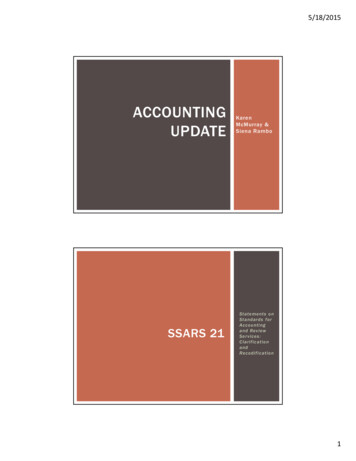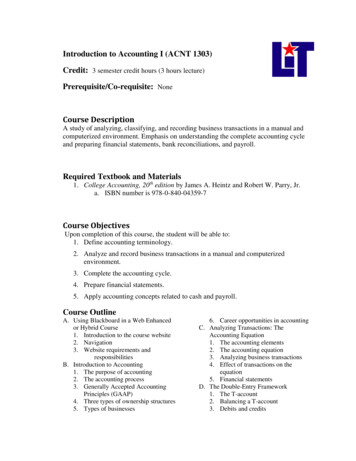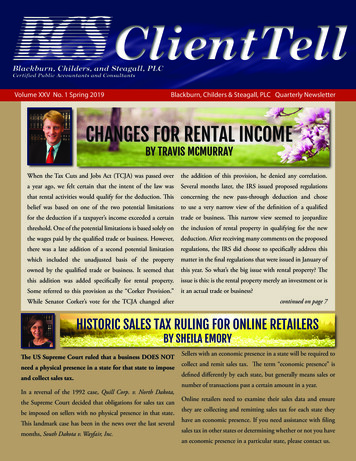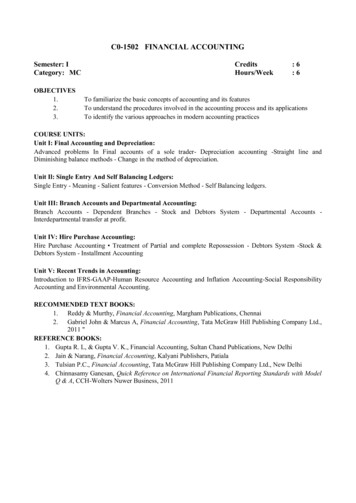
Transcription
5/18/2015ACCOUNTINGUPDATESSARS 21KarenMcMurray &Siena RamboStatement s onStandar ds forAccountingand ReviewSer vices:Clarific at ionandRecodif ic at ion1
5/18/2015SSARS 21 Issued October 23, 2014 Supersedes all AR sections (except AR section 120) Ef fective for periods ending on or after December 15, 2015(December 31 , 2015 year ends) Early implementation is permittedSSARS (Compilation &Review)2
5/18/2015FOUR SECTIONS Section 60 – General Principles for Engagements Performedin Accordance with SSARS Section 70 – Preparation of Financial Statements Section 80 – Compilation Engagements Section 90 – Review EngagementsAR-C SECTION 60 – GENERALPRINCIPLES Includes requirements and guidance with respect to: Ethical requirementsProfessional judgmentConduct of the engagement in accordance with SSARSsEngagement level quality controlAcceptance and continuance of client relationships and engagements3
5/18/2015AR-C SECTION 70 – PREP OF FINANCIALSTATEMENTS Accountant in public practice isengaged to prepare financialstatements, but is not engaged toperform an audit, review or acompilation on those financialstatements.AR-C SECTION 70 – PREP OF FINANCIALSTATEMENTS Does not require verification of the accuracy or completenessof information Report is not required No assurance provided Nonattest service – therefore, no independence determination4
5/18/2015AR-C SECTION 70 – REQUIREMENTS Comply with requirements of Section 60 Agree upon terms of engagement and document inengagement letter Obtain understanding of financial reporting framework andsignificant accounting policiesAR-C SECTION 70 – REQUIREMENTS(CON’T) Prepare financial statements “No assurance is provided” statement on financial statements Include financial reporting framework on face of financialstatements or in a note for special purpose frameworks Prepare documentation in suf ficient detail to provideunderstanding of work performed5
5/18/2015DETERMINING APPLICABILIT Y OFSECTION 70What has the client engaged us to do?SECTION 70 – ILLUSTRATION #1 Client engages accountant to prepare tax return and does notask for or expect to receive financial statements. As part of tax return preparation work, accountant preparesfinancial statements and gives to client.6
5/18/2015SECTION 70 – ILLUSTRATION #2 Client engages accountant to perform numerous bookkeepingservices. As part of bookkeeping work, accountant prepares financialstatements and gives to client.AR-C SECTION 80 - COMPILATIONS Engaged to perform compilation engagement In contrast to prior standards, which applied when accountantsubmitted financial statements to client or third parties Largely unchanged from prior standards, other thanapplicability7
5/18/2015AR-C SECTION 80 - COMPILATIONS Primary changes: Report is now required for all compilation engagements Compilation report is streamlined to differentiate from assurancereports Consists of one paragraph with no headings Additional paragraphs are required for certain situations Retains requirement to determine independence.PREPARATION VS. COMPILATION Main dif ferences:1.2.Report is issued for compilationsAccountant is required to determine independence incompilations8
5/18/2015AR-C SECTION 90 – REVIEWENGAGEMENTS Primarily a clarity redraft of the pre-clarity review literaturewith very few changes. Review report now requires:1.2.3.HeadingsCity and State of issuing officeEOM or Other-Matter paragraphs in certain mattersFAQS FROM CPEA Question #5. Can the accountant be engaged to preparemonthly financial statements and also be engaged to performa compilation engagement on the annual financialstatements? Answer: Yes9
5/18/2015FAQS FROM CPEA Question #10. If the accountant, who is not the client’sauditor, is engaged to prepare financial statements that willbe provided to an outside auditor for the purposes of theannual audit, is the accountant required to prepare thefinancial statements in accordance with Section 70 of SSARS21? Answer: YesFAQS FROM CPEA Question #12. Which engagements are required to have asigned engagement letter? Answer: All engagements performed in accordance withSSARS 21 . The letter must be signed by both the accountantand management.10
5/18/2015FAQS FROM CPEA Question #22. Are there dif ferent documentationrequirements in accordance with SSARS 21 compared to thepre-SSARS 21 standards? Answer: No significant changes have been made to thedocumentation requirements.FASB UPDATENewStandards11
5/18/2015FASB Financial Accounting Standards Board still working towardconvergence with the International Accounting Standardsboard (IASB) Revenue Recognition Lease Accounting New Accounting Alternatives for Private CompaniesREVENUE RECOGNITION Principles Based Approach Designed to promote consistency in reporting revenues Transfer of the control of goods or services to the customer is theunderlying principle No “bright-line” rules Slow start due to Questions on how to apply in certain areas Will apply to all companies currently using either U.S. GAAP or IFRS(both FASB and IASB agreement needed) Delayed implementation for 1 year(ASU) 2014-09-Revenues fromContracts with Customers12
5/18/2015REVENUE RECOGNITION Five-step Revenue Recognition Model Core Principle - “An entity must recognize revenue when it transferspromised goods and services to the customer and the amountrecognized should be the consideration to which the entity expects tobe entitled.”1.2.3.4.5.Identify the contract(s)Identify the separate performance obligationsDetermine the transaction priceAllocate the transaction price to the separate performance obligationsRecognize revenue when the entity satisfies a performance obligationIDENTIFY THE CONTRACT Specific criteria must be met Contract must have commercial substance Promised goods and services must be identified and approved Payment terms identified13
5/18/2015IDENTIFY THE SEPARATE PERFORMANCEOBLIGATIONS Applicable when more than one good or service transferred Additional good or service must be distinct Could be sold separately or customer could benefit from the good orservice on its own Not distinct if bundledExample - Sold a car with 5-yr warranty included in the purchase priceand sold a separate 3-yr extended warranty. The extended 3-yrwarranty would be a separate performance obligation.DETERMINE THE TRANSACTION PRICE Consideration which the entity expects to receive for thetransfer of the promised goods and services. Variable consideration, time, money, non-cash consideration andconsideration payable to the customer. Includes discounts, rebates,refunds, and royalties. Use either the expected value method or the most likely amountmethod Entity must have relevant experience with the item and know theprobability of significant reversals14
5/18/2015ALLOCATE TRANSACTION PRICE TOSEPARATE PERFORMANCE OBLIGATIONS Relative stand alone price of each performance obligation Management must identify observable evidence If none exists, management must use a method of estimationto determine stand-alone price Allocate consideration expected from the separate obligationsRECOGNIZE REVENUE WHEN ENTIT YSATISFIES A PERFORMANCE OBLIGATION When customer obtains control of the good or service If satisfied over time, use a progress method to recognizerevenue (input or output method)15
5/18/2015REVENUE RECOGNITION New model requires management make more estimates andjudgments:Identifying separate performance obligationsDetermining transaction priceDetermining variable considerationAllocation of transaction priceWhen control has been transferredManagement should assess and update internal controls andprocesses to avoid fraud Forecast revenue changes to determine significant changes infinancial metrics Need to show two year comparative data in financials (on face or innotes) EFFECTIVE DATES Due dates have been extended one year (announced April2015) and are now: Publically held entities with annual reporting periods beginning on orafter December 15, 2017 (with no early adoption) and for privatelyheld companies with annual reporting periods beginning on or afterDecember 15, 2018, with early adoption allowed but no sooner thanDecember 15, 201716
5/18/2015LEASE ACCOUNTING Revised Exposure Draft from FASB and IASB Lessees will record substantially all leases on the balance sheet; anasset and a lease obligation Dual model for recognition of income and expense for both lessorsand lessees Is there a lease? Classification of lease-capital or operating Leases involving real estate De-recognition treatment addressedLEASE ACCOUNTING Is it a lease? An agreement conveying right to use property, plant, or equipment(land and/or depreciable assets), usually for a stated period of time Arrangement involves use of property, plant or equipment PPE is explicitly or implicitly identified Arrangement conveys “right to use”17
5/18/2015LEASE ACCOUNTING What is NOT a lease under this topic? Inventory and minerals, precious metals or other natural resources Rights to explore for or to exploit natural resources such as oil, gas,minerals, timber, precious metals, or other natural resources Intangibles - workforce and licensing agreements, patents andcopyrightsLEASE ACCOUNTING FASB and IASB have not agreed FASB prefers dual-recognition approach for lessees wherebycapital leases would use an interest-and-amortization method,and operating leases would be expensed on a straight-linebasis IASB prefers lessees to account for all leases as a purchase ofa right-of-use asset on a financed basis Release date still uncertain GASB issued preliminary views document toward an exposuredraft which is based on principle that all leases are financingsof the right to use an underlying asset18
5/18/2015LEASE ACCOUNTING-CLASSIFICATIONS Lessee Capital Operating Lessor Sales-type leasesDirect financing leasesLeveraged leasesOperating leasesOTHER FASB ISSUES Going Concern-management responsibilities Going concern determination has primarily been performed byauditors August 2014, FASB issued standard (ASU) No. 2014-15 describingmanagement’s responsibility. Effective for years ending afterDecember 15, 2016. Early adoption in permitted Management should Make an evaluation in every reporting period (ability to continue for 1 yr) If identify doubt, state whether their plans will alleviate the substantialdoubt If plans will alleviate substantial doubt, they must be disclosed If plans will NOT alleviate, management must include a statement in thenote disclosures indicating the doubt19
5/18/2015ALTERNATIVES FOR PRIVATE COMPANIES Private Company Council (PCC) Goal to make GAAPsimpler while continuing to provide financial statementusers the information they need Exemption from having to prepare annual impairment tests Ability to elect not to recognize certain intangible assets acquired ina business combination separately from goodwill Simplified hedge accounting approach for certain interest rate swaps An exemption for the requirement to consolidate variable-interestentities in common-control leasing arrangementsIMPAIRMENT TESTS Exemption from having to prepare annual impairment tests forGoodwill subsequent to a business combination Private company that elects the alternative should amortizegoodwill over 10 years, or Less than 10 years if the entity can demonstrate anotheruseful life is more appropriate(ASU) 2014-02, Intangibles-GoodwillAnd Other (Topic 350) Accounting forGoodwill (a consensus of the PrivateCompany Council)20
5/18/2015ELECTION NOT TO RECOGNIZE CERTAININTANGIBLES Ability to elect not to recognize certain intangible assetsacquired in a business combination separately from goodwill If it is difficult to separate some of the intangibles in a businesscombination all can be amortized together and do not have to beseparately identified(ASU) 2014-18, Business Combinations (Topic 805): Accounting forIdentifiable Intangible Assets in a Business Combination (a consensusOf the Private Industry Council)SIMPLIFIED HEDGE ACCOUNTING Simplified hedge accounting approach Certain interest rate swaps Private companies other than financial institutions Convert variable-rate debt to fixed-rate debt(ASU) 2014-03, DerivativesAnd Hedging (Topic 815):Accounting for CertainReceivable-Variable, Pay-FixedInterest Rate Swaps-SimplifiedHedge Accounting Approach(a consensus of the PCC)Effective for annual periodsbeginning after12/15/1421
5/18/2015VARIABLE INTEREST ENTITIES Variable Interest Entities (VIEs) Exemption from requirement to consolidate VIEs in common controlleasing arrangements(ASU) 2014-07 Applying Variable Interest Entities Guidance toCommon Control Leasing Arrangements (a consensus of the PPC).Effective date-annual periods beginning after 12/15/14.Early implementation permittedSIMPLIFICATION INITIATIVE Don’t lose sight of the Goal! Provide financial information that helps the users of the financialstatements make sound financial decisions Rid GAAP of standards that cause preparers difficulty but providelittle relevant information for financial statement users22
5/18/2015SIMPLIFICATION INITIATIVE Extraordinary Items concept of extraordinary items has been removed-no longer have todetermine if an item is both “unusual” and “infrequent”(ASU) 2015-01 Income Statement-Extraordinary and Unusual ItemsEffective-years beginning after 12/15/15. Early adoption permitted.Once these startedThey have just kept coming!SIMPLIFICATION INITIATIVEFebruary 18, 2015:(ASU) 2015-02, Consolidation (Topic 810): Amendments to theConsolidation Analysis Intended to “simplify and improve” consolidation guidanceAffects VIE situations where consolidation does not providethe most useful information.Effective for private companies and not-for-profit organizations,with annual periods beginning af ter 12/15/16. For publiccompanies, effective for annual periods beginning af ter12/15/15. Early adoption is permitted. Any adjustments will bereflected in a modified retrospective approach with acumulative effect adjustment to equity23
5/18/2015SIMPLIFICATION INITIATIVEApril 7, 2015(ASU) 2015-03, Simplifying the Presentation of Debt IssuanceCosts Amendments require that debt issuance cost be presented inthe balance sheet as a direct deduction from the carryingamount of that debt liability No longer shown as an asset since they provide no futureeconomic benefitPublic and Nonpublic entities ef fective for fiscal yearsbeginning after 12/15/15.SIMPLIFICATION INITIATIVEApril 16, 2015(ASU) 2015-04, Compensation-Retirement Benefits (Topic 715):Practical Expedient for the Measurement Date of an Employer’sDefined Benefit Obligation and Plan AssetsFor entities with a fiscal year end that does not coincide with amonth-end, this amendment allows the entity to measure thedefined benefit plan assets and obligations using the monthend that is closest to the entity’s fiscal year end and apply thatfrom year to year.Ef fective for public entities for fiscal years beginning after12/15/15 and for all other entities, ef fective for fiscal yearsbeginning after 12/15/16. Earlier application is permitted.24
5/18/2015SIMPLIFICATION INITIATIVEApril 16, 2015(ASU) 2015-05, Intangibles-Goodwill and Other-Internal-UseSof tware (Subtopic 350-40): Customer’s Accounting for FeesPaid in a Cloud Computing ArrangementIf, cloud computing arrangement does not include softwarelicense-account for as a service contract.If, cloud computing arrangement does include software license For internal-use software, account for under ASC 350-40 For other than internal-use, use applicable standards (i.e., ifused in research-use ASC 730, Research and DevelopmentFor public and nonpublic entities, ef fective for annual periodsbeginning after 12/15/15. Early adoption is permitted.SIMPLIFICATION INITIATIVEMay 4, 2015(ASU) 2015-07, Fair Value Measurement (Topic 820):Disclosures for Investments in Cer tain Entities that CalculateNet Asset Value per Share (or its Equivalent).Removes requirement to categorize within the FV hierarchy allinvestments with FV measured under the NAVInvestments measured under NAV must be provided to permitreconciliation of FV to the amounts in the financial statementsCurrently diversity in categorizing these NAV investments; thiswill eliminate the diversityFor public entities ef fective for annual periods beginning after12/15/15 and for nonpublic after 12/15/16. Early applicationpermitted.25
5/18/2015OTHER RECENT FASB STATEMENTSSeveral last year were issued as a consensus of the FASBEmerging Issues Task Force ASU 2014-01-Investments-Equity Method and Joint Ventures ASU 2014-04-Receivables-Troubled Debt Restructurings byCreditors (Suptopic 310-40): Reclassification of residentialReal Estate Collateralized Consumer Mor tgage Loans UponForeclosure ASU 2014-05-Ser vice Concession Arrangements (Topic 853) ASU 2014-12-Compensation-Stock Compensation (Topic 718):Accounting for Share-Based Payments When the Terms of anAward Provide That a Performance Target Could be Achievedaf ter the Requisite Ser vice PeriodOTHER RECENT FASB STATEMENTSContinuation of updates issued as a consensus of the EITF ASU 2014-13 Consolidation (Topic 810): Measuring theFinancial Assets and the Financial Liabilities of aConsolidated Collateralized Financing Entity ASU 2014-14 Receivables-Troubled Debt Restructurings byCreditors (Subtopic 310-40): Classification of Cer tainGovernment-Guaranteed Mor tgage Loans upon Foreclosure ASU 2014-16 Derivatives and Hedging (Topic 815):Determining Whether the Host Contract in a Hybrid FinancialInstrument Issued in the Form of a Share is More Akin to Debtor to Equity ASU 2014-17 Business Combinations (Topic): PushdownAccounting26
5/18/2015OTHER RECENT FASB STATEMENTS There has already been one issued this year that is fromconsensus of the EITF ASU 2015-06 Earnings per Share (Topic 260): Effects onHistorical Earning per Unit of Master Limited Par tnershipDropdown TransactionsOn the horizonthe FASB is issuing for public comment a proposal to enhancethe usefulness of the financial statements of NFPs.It would change the current net asset classification scheme andthe required information about an organization’s liquidity,financial performance and cash flows.OTHER RECENT FASB STATEMENTS ASU 2014-06 Technical Corrections and Improvements Relatedto Glossar y Terms ASU 2014-08 Presentation of Financial Statements (Topic205) and Proper ty, Plant and Equipment (Topic 360):Reporting Discontinued Operations and Disclosures ofDisposals of Components of an Entity ASU 2014-10 Development Stage Entities (Topic915):Elimination of Cer tain Financial Repor ting Requirements,Including an Amendment to VIE Guidance in Topic 810 ASU 2014-11 Transfers and Ser vicing (Topic 860):Repurchase-to-Maturity Transactions, Repurchase Financings,and Disclosures27
5/18/2015FUTURE CHALLENGES Continued convergence issues More alternatives for private companies New simplification projects Health care issues Pension reporting Grant changes and the “super circular”SOURCES AICPA Center for Plain English Accounting FASB Codification28
5/18/2015CONTACT INFORMATIONSiena Rambo, CPA423.282.4511Siena@BCScpa.comKaren McMurray, CPA , CFE, CICA, CGMA423.282.4511Karen@BCScpa.com29
LEASE ACCOUNTING. 5/18/2015 19 Lessee Capital Operating Lessor Sales-type leases Direct financing leases Leveraged leases Operating leases LEASE ACCOUNTING-CLASSIFICATIONS Going Concern-management responsibilities Going concern determination has primarily been performed by auditors August 2014, FASB issued standard (ASU) No. 2014-15 describing .










